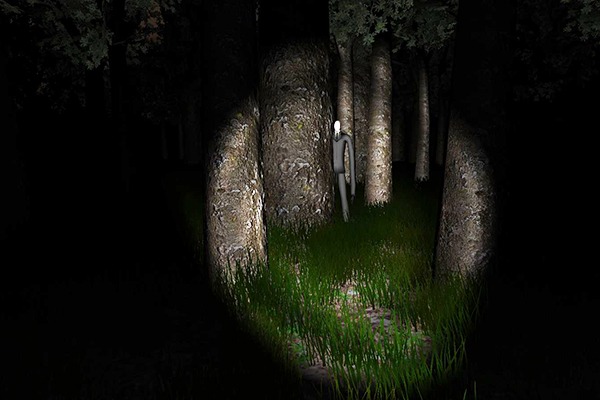
We Can’t Get Out Without Talking About Slenderman

This column is a reprint from Unwinnable Monthly #166. If you like what you see, grab the magazine for less than ten dollars, or subscribe and get all future magazines for half price.
———
We are what we’re afraid of.
———
When you think about horror games, and the things that rise up from the mire of the internet to become the stuff of 21st-century legend, you cannot avoid, nay, are compelled, to talk about Slenderman. Born of a 2009 creepypasta and culminating in the 2014 violent assault of a twelve-year-old girl by two classmates, Slenderman was largely responsible for a digital Satanic Panic in miniature. Parents of young folks (and some of said young folk were my peers, as someone who graduated high school in 2011), flew into a tizzy over whether or not their children were accessing the specific dark corners of the internet where Slenderman lived.
Frankly, remembering my time on the internet circa 2012, Slenderman was hard to avoid even if you weren’t particularly interested in him – he had a stranglehold on Tumblr and Reddit, and the sort of meta-fanfiction that happens when home content creation goes viral was omnipresent. Everyone, it seemed, wanted to contribute to the Slenderlore™. Enter Slender: The Eight Pages, a first-person survival horror game that launched in June of 2012. The game was created by an indie developer in Unity and released by Parsec Productions, the company headed and solely operated by the developer who made the game. I tell you all of this to establish both the incredible indie cred of this piece of work and to further cement the idea that Slenderman was a phenomenon that grabbed hold of the minds of the internet and simply would not let go.
The gameplay of Slender: The Eight Pages is simple – you wander a dark and endless forest, attempting to find pages from a book without being caught by the titular Slenderman. The general sense of anxiety that the game provokes in the player keeps it from seeming too repetitive and distracts from the low-quality graphics, though critics disagree on that front. The game is ultimately a very simple tribute to the cult figure that, at that point, ruled the internet with a creepily long-fingered fist.
So why devote a whole column to this game and the larger media presence of Slenderman? Well, for several reasons. First, I think this topic dovetails in nicely with my column from a few months ago about the SCP Foundation lore, and how the global haunted house of the internet can lead us into interesting play and narrative spaces in terms of horror. But also because Slenderman speaks to a particular style of information dissemination on the internet that has always existed, but has become increasingly concerning with the rise of white nationalist groups in forums everywhere that will allow them.

Part of the reason why Slenderman got as big as he did is because of the ways in which the internet allows for near-instantaneous circulation of a narrative, with people adding bits on or taking bits off every time they blog or repost. While comparing internet horror stories to the January 6th insurrection attempt may seem like a stretch, they operate under the same basic mechanism: See a thing that tickles a part of your brain, recirculate it to your internet acquaintances, watch it grow out of all control. And as the introduction to this column points out, the Slenderman myth did lead to acts of violence when people who had a particularly hard time discerning reality got ahold of the story – the comparisons begin to write themselves here.
So, I guess in a way Slenderman, his videogame and all of his associated mythos are somewhat of a cautionary tale about the perils of internet content, where everyone can be an author and credible editors are in relatively short supply. Back in the early days of Web 2.0, the internet was a lawless place, where everyone had to suss out credible content for themselves. And now, an entire decade later, the situation has not much improved, with late-adopters of social media technology left well behind on the curve of digital literacy (here’s looking at you, all my uncles on Facebook). So, while the myth of the Slenderman may seem a harmless thing in itself, it speaks to a much larger and more damaging phenomenon that comes part and parcel, maybe unavoidably so, with the memes we all consume daily.
So, okay, this one wasn’t really about videogames. But I do think that thinking about Slenderman as a test case in the fight for increased digital literacy can be illuminating. Perhaps this can prompt some slightly more critical consumption not just of the media we automatically think of as “art,” but of the smaller stuff, too – creepypastas, chat forums, etc. It all ends up in our brains the same, and the brain is generally very bad at sorting out credible data from non-credible data, so its up to us to monitor and be skeptical about what we consume.
———
Dr. Emma Kostopolus is an Assistant Professor of English at Valdosta State University. Online, you can find her nowhere, but check out her film reviews for Ghouls Magazine and her recent article for Computers and Composition Online. She’s also the co-author of Ace Detective, a murder mystery dating sim you can play at oneshotjournal.com.




